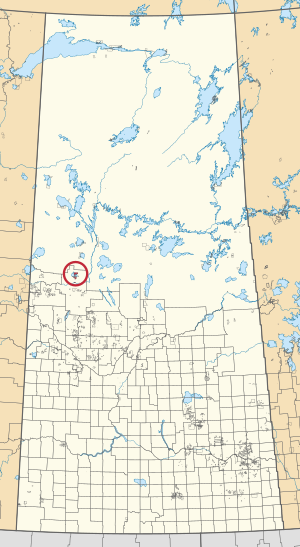Waterhen 130 facts for kids
Quick facts for kids
Waterhen 130
|
|
|---|---|
| Waterhen Indian Reserve No. 130 | |

Location in Saskatchewan
|
|
| First Nation | Waterhen Lake |
| Country | Canada |
| Province | Saskatchewan |
| Area | |
| • Total | 7,972.2 ha (19,699.7 acre) |
| Population
(2016)
|
|
| • Total | 672 |
| Community Well-Being Index | 51 |
Waterhen 130 is a special area of land in Saskatchewan, Canada. It is a home for the Waterhen Lake First Nation people. This community is located about 39 kilometers north of a town called Meadow Lake.
In 2016, a count showed that 672 people lived in Waterhen 130. They lived in 196 homes. A special score called the Community Well-Being index was 51 out of 100 for Waterhen 130. This score helps us understand how well a community is doing.
Contents
About Waterhen 130
Waterhen 130 is known as an Indian reserve. These are lands set aside for the use and benefit of First Nations in Canada. They are protected by law. This specific reserve belongs to the Waterhen Lake First Nation.
Where is Waterhen 130?
This reserve is located in the Canadian province of Saskatchewan. It is found in the northern part of the province. The closest larger town is Meadow Lake. Waterhen 130 is about 39 kilometers north of Meadow Lake.
The Waterhen Lake First Nation
The Waterhen Lake First Nation is a group of Indigenous people. They are part of the larger Cree nation. First Nations are the original inhabitants of Canada. They have their own cultures, languages, and traditions. The Waterhen Lake First Nation governs its own community on this reserve.
Community Life and Well-Being
In 2016, a count of the population was done. It showed that 672 people lived in Waterhen 130. They lived in 196 houses. There were 213 houses in total on the reserve at that time.
The Community Well-Being index helps measure how well communities are doing. It looks at things like education, jobs, and housing. For Waterhen 130, this score was 51 out of 100 in 2016. This score was compared to other communities. The average for all First Nations communities was 58.4. For non-Indigenous communities, the average was 77.5. This index helps show areas where communities might need more support.

